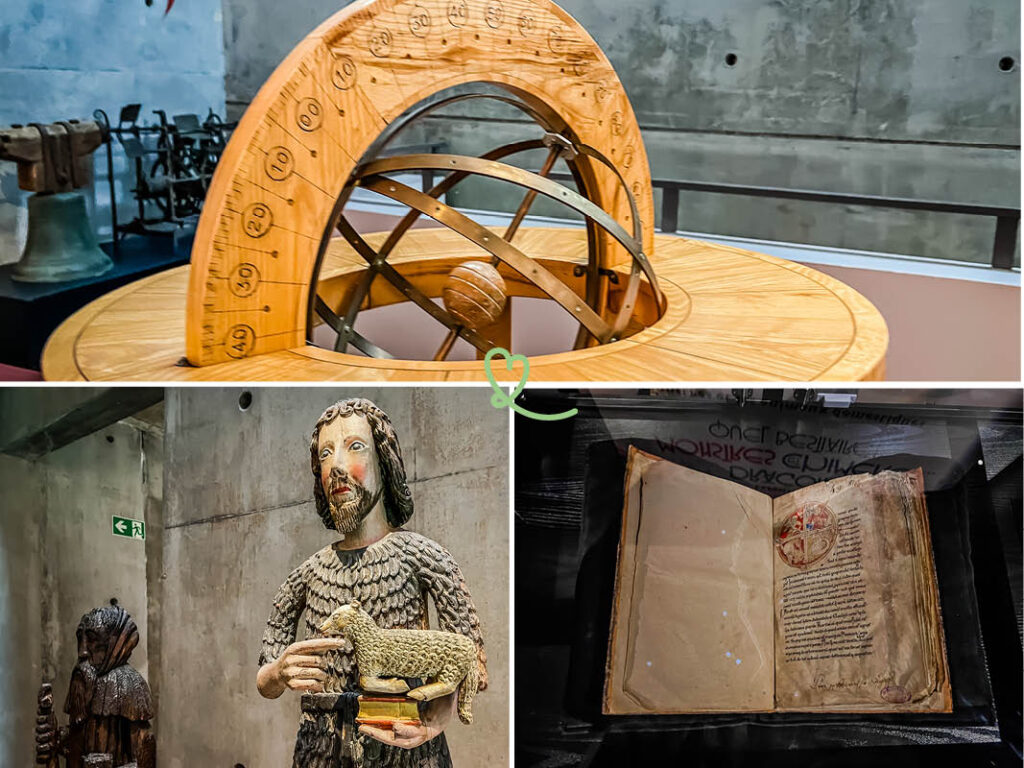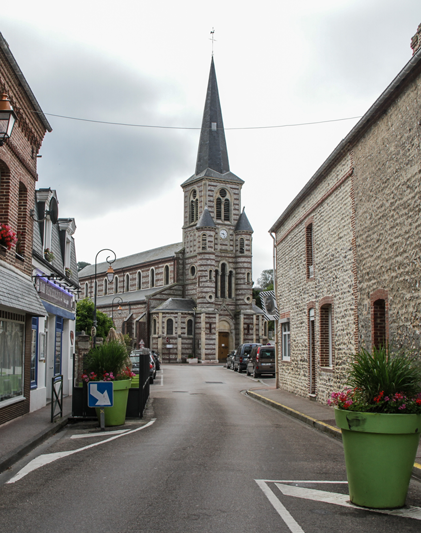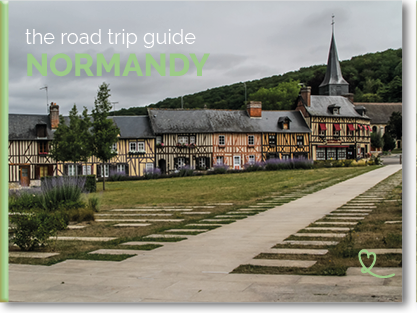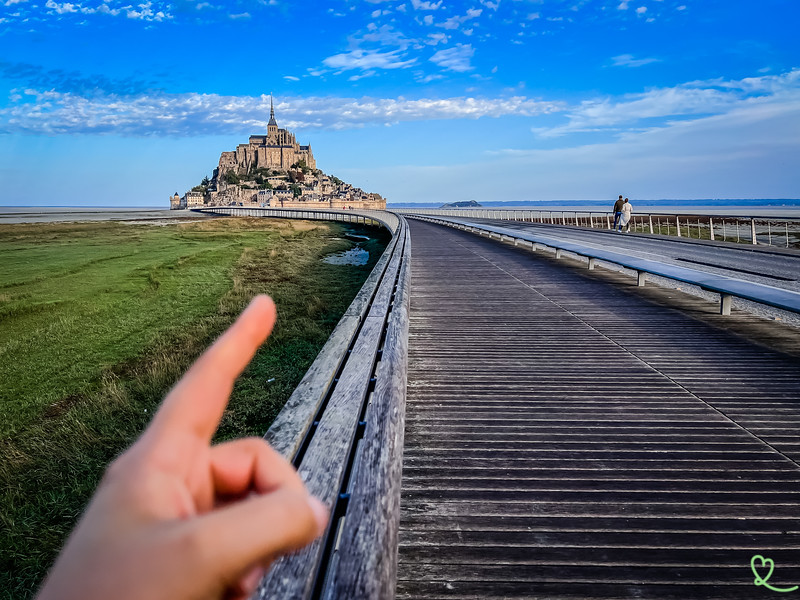Visit the Scriptorial Museum of Avranches, the only museum in France dedicated to the presentation of ancient manuscripts. Also, you will discover in this museum perched in the ramparts of the city of Avranches a magnificent collection of manuscripts of the Abbey of Mont-Saint-Michel.
In this article, we give you all our advice to visit this incredible cultural place dedicated to the history and art of writing.

This review is completely independent, we visited anonymously and paid our entrance tickets in full.
Why visit the Avranches Scriptorial Museum?
Is the Scriptorial near Mont-Saint-Michel worth it? Our opinion:
Yes, for us this museum is really worth the trip! The Scriptorial is a very modern space with a fascinating educational tour on the secrets of the first books and the history of Mont-Saint-Michel. It is one of the 7 museums to do in and around Mont-Saint-Michel.
We were overwhelmed by the beauty, the authenticity of the ancient manuscripts and the conservation process:
- The medieval fortifications, ramparts of the old castle of Avranches, inside which the museum is located.
- The original and interactive tour proposed by the Scriptorial with digital tools adapted to young and old.
- The variety of the collection pieces exhibited in the different rooms.

Before or after your visit to the Scriptorial, you may want to visit the Abbey of Mont-Saint-Michel, a jewel of architecture and history not to be missed in the region – see our visit tips.
Why is the Scriptorial Museum famous?
The Scriptorial of Avranches is the only museum in France dedicated to the presentation of ancient manuscripts dating from the 9th to the 15th century. Thus, you can admire the sublime collection of the Abbey of Mont-Saint-Michel. The museum permanently exhibits a selection of manuscripts and alternates every three months. There is also always a temporary exhibition on a given theme.
This collection on parchments highlights the talent of the monks in the art of illumination, calligraphy and their extraordinary intellectual gymnastics!

What we liked best about it
Of course, we detail later in this article the route of our visit. But we couldn’t help but reveal our favorite part of the museum right now!
On the second level of the Scriptorial, the Treasury, or manuscript room:
- With a collection of 205 collections on preserved parchments (selection exhibited in rotation every three months),
- Among these are extracts of astrology, literary works, musical studies and treatises, theological commentaries…

Finally, we also really enjoyed touching the tools and materials used to make the Mont-Saint-Michel manuscripts.

The explanations were very entertaining and clear about the work of the monks to produce the ancient manuscripts. A moment that will remain engraved in our memory, we do not use material like in the Middle Ages every day!

Useful tips: Scriptorial Museum, Avranches, France
Where the Scriptorial Museum is located
The Scriptorial Museum is located at 6 Place d’Estouteville in Avranches (50300) in Normandy. It is a neighboring commune to Mont-Saint-Michel.
- Driving time from Mont-Saint-Michel: 40min.
- Driving time from Rouen: 02h35.
- Driving time from Caen: 1h15.
- Driving time from Bayeux: 1h15.
- Driving time from Rennes: 1 hour.
- Driving time from Cherbourg: 01h45
OUR ADVICE FOR RENTING A CAR IN Normandy
- Compare prices on our preferred platform: DiscoverCars – one of the best rated sites.
- Choose a car that is comfortable enough (distances can be long) but compact (some parking lots and villages are narrow).
- Think of thecomplete insurance (some roads are tortuous and narrow).
- There is a lot of demand, book it early.

How to get there
As you can see, the easiest way to get there is by car. Indeed, you will be able to park easily in the streets near the museum.
Private tours and excursions are organized from Caen, Bayeux or Paris. Remember to book your time!
Note that access by train is also possible. The city of Avranches also has an SNCF train station – see train prices and schedules.
Parking
Don’t panic, a parking lot is open to the public on the Place d’Estouteville in front of the museum. Otherwise, you can also park near the Tourist Office which is 200m from the entrance of the Scriptorial Museum.

Best time to visit the Scriptorial Museum of Avranches
The peak times are at 10am and 3pm. Choose the late morning for example and avoid the high season if you don’t like the crowd. Despite this, the museum is well laid out and has enough space even when it is very busy.
Personally, we prefer to visit these cultural places when it is less crowded to take our time in front of each work along the way.
How long to visit the Scriptorial and main difficulties
Allow 1.5 to 2 hours for your visit, depending on whether you are visiting the permanent exhibition only or the temporary exhibition as well.
There are no particular difficulties because the course is on a gentle slope. The museum is accessible to people with reduced mobility.
Please note that pets are not allowed inside, only guide dogs are allowed in the museum.

Advice on how to visit
Then concerning the direction of the visit, it is unique and marked out. More precisely, the museum extends over two levels, designed in the image of Mont-Saint-Michel and its abbey. In other words, the course is uphill on a gentle slope. Thus, for a logical continuation and coherence of the contents of the visit, we advise you to go there just before or just after a visit to Mont-Saint-Michel.

The Scriptorial Museum with children
Please note that the Scriptorial has a changing area for small children. On foot, in a stroller or in a baby carrier, you can easily move around the museum with your little ones.
If you are visiting the Scriptorial with your family, there is a tour adapted for children under 12 years old. Inside the museum, the little demon of the copyist monks Titivillus will serve as a guide for your children during the visit. A playful and educational discovery of the history of Mont-Saint-Michel for the youngest!
Meet at the museum reception desk to pick up a fun guide for each child.

Schedules and prices
Schedules:
- From April to June and in September, open from 10am to 1pm and from 2pm to 6pm from Tuesday to Sunday (last entry at 5pm).
- In July and August, open from 10am to 1pm and from 2pm to 7pm from Tuesday to Sunday (last entry at 6pm).
- In February, March, October, November and December, open from 2:00 pm to 6:00 pm from Tuesday to Saturday (last entry at 5:00 pm).
- Closed in January and on public holidays (May 1, November 1, December 25).
Rates:
- Permanent tour and temporary exhibition: 8 € per adult.
- Temporary exhibition only: 3 €.
- Free admission for children under 18 years old accompanied by an adult (upon presentation of proof).
- Reduced rate: 4 € (see conditions on the museum website ).
From April to September, the entrance is free every first Sunday of the month (except on public holidays).
Guided tours are also possible, you can also find all the information on the official website of the museum.
Unfortunately, the audio guides are temporarily unavailable.
USE OUR GUIDE TO PLAN A
DREAM TRIP TO Normandy
All the information you need for your trip:
- 8 maps that make planning easier
- 160+ pre-selected locations
- Practical advice
- 300+ photos to help you choose

1st level: Mont-Saint-Michel, medieval history
The foundations of Mont-Saint-Michel
The Scriptorial Museum was built as a metaphor for Mont-Saint-Michel, making your visit a truly unique experience! Little by little, you climb the gentle slope to the first level to discover the history of the foundation of Mont-Saint-Michel.

It is Saint-Aubert, bishop of Avranches, who erected the first sanctuary on the Mont-Saint-Michel in the 8th century to the glory of the archangel Saint-Michel. On the right, on the picture you can see a statue of him.
In the ancient texts, the founder of Mont-Saint-Michel and its abbey is indeed the bishop Saint-Aubert. Finally, the prestigious relic of the body of the bishop of Avranches reappeared in the 11th century on Mont-Saint-Michel.

In this first room, admire the details of the antique objects on display. Here, a reliquary angel in silver, onyx and crystal dating from the 19th century.
Mont-Saint-Michel and Avranches: 2 medieval villages
Thousands of pilgrims came from different countries to visit this sacred place that represents the Mont-Saint-Michel. In the village on the rock, archaeologists discovered the remains of a workshop for the manufacture of molds for the pilgrimage signs of Mont-Saint-Michel.

The monks had these molds made on request. Take the time to distinguish the precision of the engraving and the patterns on the mold. Engraved in low relief in slabs of schist or limestone, the craftsmen founders used these molds to design the pieces based on a mixture of lead and tin.

The monks entrusted the creation of the molds and the sale of pilgrimage objects to the craftsmen of the workshop, who gave a part of the profits to the abbey.

In the Middle Ages, the city of Avranches was at the origin of the foundation of the duchy of Normandy. At the end of the 5th century, it became the seat of a bishopric. The Bretons occupied the city of Avranches for a time but it became Norman almost 500 years later.
In this space, you will discover enamelled paving stones of the XIIIth century still perfectly preserved as on the image below.

But also, paintings showing the city of Avranches in the 17th century like this magnificent oil on canvas by Charles Fouqué.

Do you love all kinds of art? There is something for everyone! After the sculptures, statues and other paintings, let’s go to the architectural pieces!
A series of architectural elements are exposed in the rest of the tour, from the Gothic period to the 15th century.

The medieval cellar
Let’s continue in the medieval cellar, just after the projection room. The cellar is a vaulted space, the last vestige of the medieval period on the site of the Scriptorial Museum. Archaeologists think that this place constitutes the first floor of a house of the time but without certainty.

The city of Avranches had many stone houses called “rooms on cellar”. The structure of this room is partially reminiscent of the architecture of the old town of Avranches.
Continuation to the 2nd level: the making of the Mont-Saint-Michel manuscripts
A meticulous manufacturing process
Then go up to the second floor of the museum to discover the secrets of the making of the manuscripts of Mont-Saint-Michel. We are always impressed by the degree of knowledge of researchers and archaeologists on the achievements of the time!

At first, the monks copied the manuscripts on paper and cut out sheets of parchment. Did you know that copyists used a compass to pierce the sheet and scratch its surface? This allowed them to write straight on the parchment, we discovered another use for the compass!

Ink making, gilding, illumination… The monks possessed very elaborate equipment to produce these precious manuscripts.

In this room you will find a variety of objects used by the monks:
- Goose or woodcock feathers,
- Inkwell,
- Knife,
- Shellfish,
- Boar’s tooth,
- Now,
- Agathe,
- Clay,
- and many others…
A MAGICAL EXPERIENCE AT Mont-Saint-Michel
Step 1: Plan and get there

Step 2: Decide on your program

Step 3: decide where to sleep

From manuscripts to first books
The copyist monks were subject to very strict rules to lay out their parchment and facilitate its reading. They had a palette of colors at their disposal for illumination, or the art of decorating parchments.

The word “illumination” comes from the Latin illuminare which means “to illuminate”. Red, blue, green, yellow or white pigments were made from different raw materials. Thus, these pigments illuminated the ancient manuscripts. What an art!

Afterwards, you will notice that the course is always as educational and enriched, for young and old alike! Large panels explain all that the manuscripts have taught researchers and archaeologists about the life of the monks on the Mount, apart from matters of faith. The library of the Abbey of Mont-Saint-Michel consisted mainly of religious works. There were also texts that could enlighten the monks on contemporary debates such as human freedom or the independence of the Church from political power.

You can even sit down with your kids to play a memory game with the illumination patterns! A small table is at your disposal for you or your children while you visit the room.

A little further on, we really liked the many astrological and astronomical instruments, especially for telling the time by the stars!
The manuscripts of Mont-Saint-Michel
Finally, the Treasury: manuscript room
After your journey in the museum, going up little by little this cultural place in the image of the Mont-Saint-Michel, you finally arrive at the Treasure: the room of the manuscripts. Icing on the cake!
The darkness bathes in this vault to preserve the ancient manuscripts, some of which are over a thousand years old.

We were really fascinated by the meticulousness and precision of the calligraphic art on the scrolls. Take here this excerpt from Aristotle’s Physics, a manuscript dating from the 14th century. Come closer to see the very homogeneous and neat gothic writing of this parchment. A true wonder!

Fragments of older manuscripts are also on display in the Treasury Room. Above, see a fragment of the Gospel of Luke reused in the twelfth century as a title page and binding of the manuscript.

In this room you will find excerpts from astrology, religious services and musical studies! The collection of manuscripts of the Abbey of Mont-Saint-Michel offers a great variety of texts.
The temporary exhibition
Still on the second level of the museum, we were plunged into a chimerical universe with the temporary exhibition Dragons, monsters, chimeras… What a bestiary! Indeed, the collection of manuscripts of Mont-Saint-Michel is fed by mythological figures.
Fantastic creatures, monsters or characters of fables, we were transported in this medieval imagination where animals hold a central place.

The temporary exhibition is installed in the Treasure Room, the museum selects some manuscripts in connection with its theme.

This exhibition on the mythological world that inspired the illuminators of manuscripts of the time is staged in the manuscript room. For conservation and preservation of the manuscripts, the pieces are exhibited in rotation every three months.

Note that animals are really omnipresent in the Middle Ages. Whether it was horses, cattle or even bees, everyone contributed something to medieval society: transportation, combat, work or food. Even the pharmacopoeia used venom and leeches to treat certain ailments!
A little history
Avranches, city of heritage
At the time of the French Revolution of 1789, Mont-Saint-Michel and its abbey, property of the Church, were declared “national property”. Thus, it is the city of Avranches that inherits all the books and writings sheltered by the Abbey of Mont-Saint-Michel.
For a long time, some manuscripts were kept in the old municipal library of the Avranches town hall. In the past, it was open to the public.

In the early 1990s, a project for a national manuscript center was launched. The Scriptorial Museum, with its contemporary style and its 1500m2 of surface, was created in 2006. Let us mention that it is built in the ramparts of the old castle of Avranches.
The origins of the Scriptorial Museum
The name of the museum is a contraction of the word “scriptorium”, a workshop where copyist monks worked before the beginning of printing, and the word “memorial”.

This museum pays tribute to Saint Aubert, bishop of Avranches at the end of the 7th and beginning of the 8th centuries, who undertook the construction of a sanctuary dedicated to the archangel Saint-Michel. The bishop Saint Aubert then became the founder, according to ancient texts, of Mont-Saint-Michel and its abbey.
Lodgings in the vicinity
WHERE TO STAY AT Mont-Saint-Michel
Option 1:
Choose one of the 7 hotels on the mountain, within the city limits – see our article
- The historic Auberge Saint-Pierre Hotel – see prices, photos and availability

Option 2:
Or sleep in the part called La Caserne which is between the parking lots and the footbridge to Mont-Saint-Michel.
- Mercure 4-starhotel – see prices, photos and availability

Option 3:
And if you are looking for luxury, check out our article dedicated to luxury hotels near Mont-Saint-Michel.
- The charming guest house Clos de Gilles – see prices, photos and availability

Option 4:
The Normandy countryside is very green and inspiring. At the bend in the forest or in the fields, pretty villages with beautiful buildings transport you to another world, or even another era.
- Hotel Ermitage at 5min – see prices, pictures and availability
- Château de Boucéel at 30min – see prices, pictures and availability

Nearby restaurants
If you want to eat in Avranches, here are some suggestions:
- Le Grand Café de l’Union Restaurant – a chic bistro that honors local products.
- Restaurant La Croix d’Or – refined French cuisine in an authentic setting.
If you are passing by Mont-Saint-Michel, you can opt for restaurants within the city, at the Caserne or in the neighboring towns.
To decide which place will be the best for you, read all our advice on the 12 best restaurants to eat in and around Mont-Saint-Michel.
Subscribe to our Newsletter
- Get away from it all with Region Lovers’ beautiful destinations!
- Once a month
- Advertising-free
Not to be missed nearby
A trip to Mont-Saint-Michel
If you are visiting the region, don’t miss the magic of Mont-Saint-Michel:
- Its fortifications and ramparts,
- Its abbey, a jewel of architecture and history,
- Its museums in and around the city.
You will surely like to find all our tips to visit the Mont-Saint-Michel!

The plant garden of Avranches
As if suspended between heaven and earth, the plant garden of Avranches offers a breathtaking view of the Bay of Mont-Saint-Michel. This magical place, where camellias and rhododendrons mingle, has inspired many French romantic authors such as Guy de Maupassant, Victor Hugo and Stendhal.

Practical information:
- The garden has convivial spaces and a playground for children.
- Please note that the access for disabled persons is temporarily closed due to construction.
- The garden is open all year round from 8:30 am to dusk with free access.
The ruins of the castle of Avranches
This construction, which began in the 10th century, was launched at the request of Richard I, Count of Normandy. The builders first erected a square stone keep. It is only in the XIIIth century on order of Louis IX that the rest of the fortifications are built to surround the medieval city.

In the 19th century, the castle as well as the keep and the fortified doors were destroyed. The bombings of the Second World War further demolished the rest of the building. But these ruins are really worth a visit! Admission is free.
The Saint-Gervais basilica
The neoclassical basilica of Saint-Gervais in Avranches, built in the 19th century, was spared the bombings of the Second World War.

Know that this basilica has a particularity, its implantation is located on the site of an ancient forum. In addition, the Saint-Gervais basilica houses the relic of Saint-Aubert, bishop of Avranches and founder of Mont-Saint-Michel, a fabulous treasure for archaeologists! This relic is also a real curiosity because it has the mark of the finger of the archangel Saint Michael. This monument is located in the historical heart of the city of Avranches and the entrance is free.
Frequently asked questions
What exhibitions at the Avranches Scriptorial Museum?
In the Scriptorial Museum of Avranches are exposed permanently:
- A large collection of manuscripts from the Abbey of Mont-Saint-Michel,
- Ancient and sacred objects,
- Wooden and ivory statues of the time.
You will also have the opportunity to visit the temporary exhibitions, for about a year for each one according to the themes. For example, during our visit, we saw Dragons, monsters, chimeras… What a bestiary! on the place of animals in the medieval imagination and ancient manuscripts.

Where are the manuscripts kept?
Older manuscripts are kept in a vault or safe where humidity and temperature can be controlled. There are several places of archives and conservation in France:
- Public or specialized libraries(BnF, municipal libraries),
- Documentation and archive centers,
- The cultural places of exhibition and preservation of art objects like the Scriptorial of Avranches for example.
Who wrote the manuscripts in the Middle Ages?
In the Middle Ages, the writing and copying of ancient manuscripts was the responsibility of the copyist monks. Literary, scientific, theological works, poems, historical treaties… The monks transformed these texts into manuscripts, from the writing of the parchment to the art of calligraphy and illumination to illustrate the works.
This work was most often done in the abbeys, where the monks lived, in the scriptorium.
Our top 3 things to do at Mont-Saint-Michel
Walk to the mount

Many people rush inside the Mont. They get out of their car, get on the shuttle and follow the people inside. But, in our opinion, choosing to walk there from the parking lots is the best option.
The path is flat and easy. Count 40min to 50min of walking.
Enjoy the sea air and the changing landscape as you approach the mountain; with the dam, fields, sand…
The anticipation makes the experience even better!
Visit the Abbey

The jewel of Mont-Saint-Michel is of course the abbey built over the centuries on top of this rocky island.
It is a marvel of architecture and history.
It is particularly known for its cloister built in the 13th century, as if suspended between sky and sea.
Be careful, there are a lot of stairs to visit it.
And you have to book your visit before – bookhere
See all our tips
Explore the ramparts

In addition to the main street and the abbey, do not miss the ramparts.
We recommend that when you arrive at Mont-Saint-Michel, you go up to the abbey by the ramparts and come back down by the main street or other alleys.
Going up the covered way offers you views of the village, the roofs, the abbey and the bay. Probably our favorite part of the visit to the Mont outside the abbey.
And to learn more:
Our complete selection of 21 things to do in Mont-Saint-Michel



